#Austronesian
Text
One thing that stands out to me about the shift to an entirely open syllable canon in Austronesian in general (and Oceanic in particular) is just how obviously recent it is in so many of these languages.
Of course, this isn't true in all cases, Polynesian seems to have lost coda consonants fairly early on (though of course they show up in passives in -ia and abstract nouns in -anga, so they were definitely still around when those forms underwent univerbation).
But others really show some narrow margins, particularly when paragoge is involved rather than coda deletion. In Roviana on the Solomons, for instance, paragoge clearly must have taken place after the lenis reflexes of other stops underwent lenition. Indeed, the Waterhouse dictionary gives a nice Roviana-exclusive doublet ŋuzapa/ŋuvasa 'wash' which showcases this nicely.
In still other instances, the split ends up just being so razor-thin that you can imagine this change having happened within the past couple of generations even. Most stiking in this instance is the split between Uneapa Bali and Vitu, where paragoge is basically the only thing distinguishing these two languages, to the extent that they get a single chared sketch grammar in the Routledge handbook on Oceanic languages; see doublets such as Uneapa Bali rumaka 'house', boroko 'pig', ɣuzaŋa 'rain', maɣuripi 'alive' vs. Vitu ruma, boro, ɣuza, maɣuri 'ibid.' (POc *Rumaq, *boRok, *qusaŋ, *maqurip). A similar hair-thin split based on paragoge occurs with Talaud as well.
I do wonder what this means for any discussion of the notion of 'drift' in contexts such as these. Of course the notion s first of all an identification of a common trend rather than an actual meaningful historical claim, so I don't think it's necessarily an issue to say that some Austronesian languages shift to an open syllable canon later than others. But it's definitely somewhat troublesome for the idea that this could have been a contact effect with non-Austronesian languages (particularly with paragoge), because many of these languages have been around in the areas they currently inhabit for a good while longer than the sound changes would suggest per this hypothesis.
35 notes
·
View notes
Text
[OPEN ACCESS] “How Taiwan Became Chinese: Dutch, Spanish, and Han Colonization in the Seventeenth Century” by Tonio Andrade
Table of Contents
Acknowledgments
Preface
Reader's Guide
Introduction
1. Taiwan on the Eve of Colonization
2. A Scramble for Influence
3. Pax Hollandica
4. La Isla Hermosa: The Rise of the Spanish Colony in Northern Taiwan
5. The Fall of Spanish Taiwan
6. The Birth of Co-Colonization
7. The Challenges of a Chinese Frontier
8. "The Only Bees on Formosa That Give Honey"
9. Lord and Vassal: Company Rule over the Aborigines
10. The Beginning of the End
11. The Fall of Dutch Taiwan
Conclusion
40 notes
·
View notes
Text
Thinking about Austroasiatic substratal influence in Malay/Javanese. I took these recons from Sidwell (2024)
cf.
*k.laŋ 'eagle' > əlaŋ 'id.' (Javanese & Malay)
*ɟ.ruːʔ 'deep' > ɟəro 'deep/inside' (Javanese)
*suc 'ant' > səmut 'id.' (Malay & Javanese)
*g.waŋ 'throw' > guwaŋ 'throw away' (Javanese)
*s.kam 'chaff' > səkam 'id.' (Malay & Javanese)
Note that it seems that in Javanese loans *k- initials seem to correspond to zero, because *kɲɔːm 'youthful' > (ə)nom 'id.' same with *k.laŋ 'eagle' > əlaŋ
However, a correspondence that I might have missed is that, maybe the word 'crevice' or 'hole in natural environment' is also of AA origin?
In Malay, the word for 'ravine' or 'crevice' is ɟuraŋ but I'm not sure why there's a /u/ there, whether that'd have any implications with the research of Proto-Austroasiatic at all. There's also the very real possibility that it could be a coincidence, but considering the other correspondences, I doubt that it's just a coincidence.
As with other loans from AA to Malay/Javanese, an /ə/ is inserted to break up the initial minor syllable, but as shown with *g.waŋ, there is an /u/ inserted if the major syllable .
Is there a precedent of reconstructing PAA *ɟ.raŋ as having a labial glide or a vowel quality of some sort? Again, this could be just a coincidence but I'm curious whether there's a possibility since ACD doesn't list any cognates for 'crevice' or 'ravine' of AN origin.
12 notes
·
View notes
Text


Descendants of the First Seafarers
Some of the ancestors of the native peoples of Madagascar, Malaysia, Indonesia, and the Pacific Islands (Micronesia, Melanesia, Polynesia) came from an ancient seaborne migration out of Taiwan and the Philippines (2200 BCE - 1250 CE). Cultural traditions still shared among these far-flung peoples today include tātau (tattoos), jade carving, stilt houses, and the cultivation of taro, pork, rice, coconuts, and yams.
#austronesian#pinoy#polynesian#melanesian#micronesian#aanhpi#maori#rapa nui#malagasy#oil on wood#tatau#pacific islander#size chart#gay art
18 notes
·
View notes
Text
youtube
Maisey Rika - Tangaroa Whakamautai (Māori)
#slow folksy soulful pop#maisey rika#tangaroa whakamautai#māori#maori#te reo māori#austronesian#new zealand#oceania#2012#2010s#pop
12 notes
·
View notes
Text


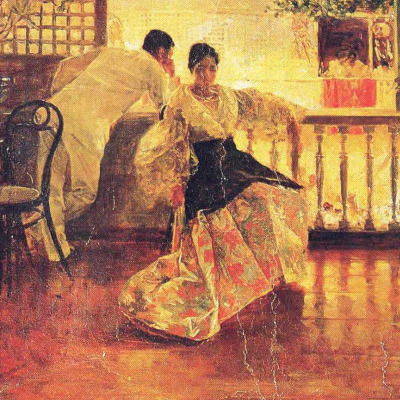






Aesthetic of the languages on earth : Tagalog
Tagalog is an Austronesian language spoken by 82 million people over the Philippines. It is an official language of The Philippines.
#tagalog#languages#language#austronesian#malayopolynesian#asia#southeast asia#philippines#the philippines
21 notes
·
View notes
Text


subgroups of malayo-polynesian languages, excluding oceanic & formosan, plus a map of possible relations between each other (uncompressed images in the cut)
full-size, uncompressed images can be found here, plus a blank map cause y not: https://imgur.com/a/z6qVsQ9
#linguistics#languages#map#geography#austronesian#malayo-polynesian#confusing diagram#there had to have been a clearer way for me to convey this information
4 notes
·
View notes
Photo
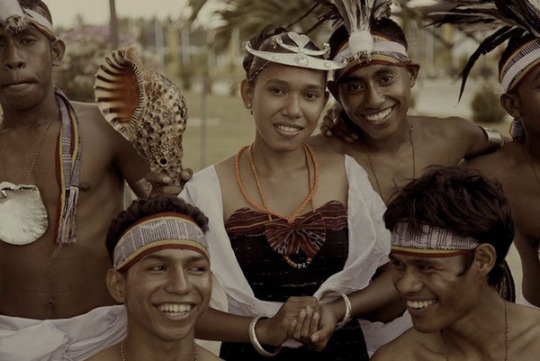
East Timor
37 notes
·
View notes
Text
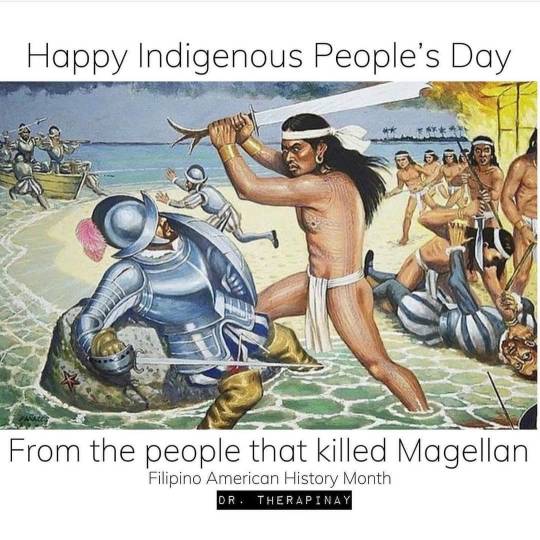
Viva! ✊🏽Mabuhay!🇵🇭 #N8V 🤎🖤
#Mu🌏#N8V#indigenous peoples#indigenous peoples day#naidoc#aboriginal#decolonize#decolonize everything#native filipino#pinoy#indigenous filipino#austronesian#malayo-polynesian#lapu-lapu#ferdinand magellan#battle of mactan#1521#native pride#bayani#mandirigma#kali-eskrima-arnis#colonizer death appreciation
43 notes
·
View notes
Text
does anyone wanna talk about austronesian linguistics with me without getting a lil too nationalistic about it
5 notes
·
View notes
Note
Whence did Yapese get their glottalized consonants? Syncope of CVʔ creating Cʔ or?
You've driven me mad with this question because I thought I'd seen a paper that basically says that it was something else but I can neither find it on my thumb drive nor can I find it on Google Scholar.
After a bit more digging, though, I have managed to dig up a book The Synchronic and Diachronic Phonology of Ejectives by Paul Fallon which gives the following examples from Blust (1980) (which I guess I might have to track down) on page 313, which seem to suggest that was part of the story (contrary to my earlier presuppositions):
*buRteq → buut’ 'earth, ground'
*ma-taqu → mat’aaw 'right hand'
*taqi → t’aaj 'faeces, waste'
Although of course Yapese is basically an isolate within Oceanic so there's difficulty finding cognates to begin with, so I do have to wonder where most of the vocabulary with ejectives must have come from.
28 notes
·
View notes
Text
a too-common misconception about the origins of filipinos is that we are all descended from the aeta. we are not. “aeta” refers to a specific ethnic group native to certain places in luzon such as zambales and pampanga, but is also commonly used as an umbrella term for several related ethnic groups across the philippine archipelago. they are identified by physical characteristics such as dark skin and very curly hair (leading to a false belief that they are descendants of black africans) as opposed to those of majority of the country who have lighter skin and hair that is either straight or of looser curl patterns (also falsely believed to be markers of the so-called malay race.)
the aeta are an ethnic minority; as of 2010, there were a documented <100,000 out of millions of filipino citizens identifying as such. it is clear majority of filipinos are not of aeta descent. so where does this myth that all filipinos “descend” from the aeta come from?
generations of miseducation has led the average filipino to believe that, out of the hundreds of ethnic groups native to the philippines, it is the aeta in particular who are the original people who came to the philippines prior to the advent of the austronesian expansion. in other words, filipinos view the aeta as a pure people who are remnants of the old world.
this is not true because:
DNA evidence from the luzon aeta, mamanwa ata, batak, & other similar peoples indicate ancestry from BOTH the earliest settlers of what is now the philippines (commonly referred to colloquially and in the literature as negritos but also sometimes as basal australasians and first sundaland peoples) and later migrants associated with the austronesian expansion.
all other native populations in the philippines save for igorot peoples also show admixture from both negrito/basal australasian/first sundaland peoples and later migrants, most significantly the austronesian speakers. what’s notable is the varying degrees of admixture among aetas and non-aetas.

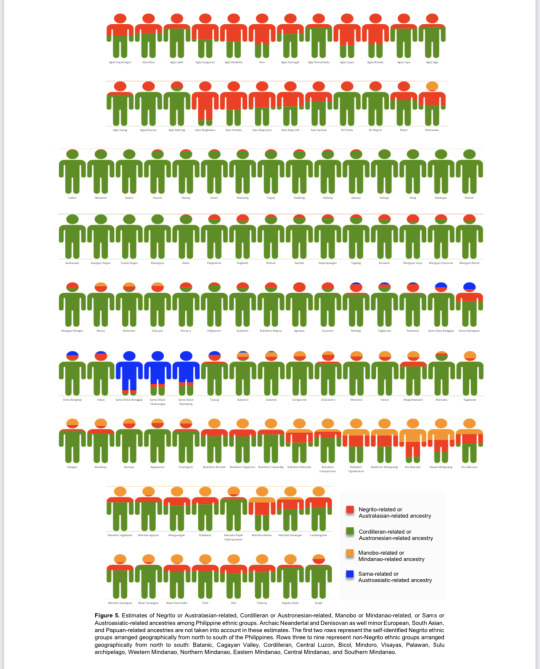
two graphic charts showing the peopling of the philippines and genetic admixture in modern populations. taken from the study, “Multiple migrations to the Philippines during the last 50,000 years” (2021) by Maximillian Larena et al.
i think what has happened is that “aeta” has become synonymous with the earliest inhabitants of the philippines, the real name for these ancient peoples being unknown to us moderns. it is only the flawed tendency to view indigenous peoples as unchanging relics of the past that has led to the biggest mistake filipinos make when discussing our origins: that is, the constant misuse of the term “aeta” to mean “pureblooded original people” when in reality aeta peoples are also descended from later migrants. when people say filipinos are descended from the aeta, they really mean to say filipinos are descended from the first settlers.
aeta peoples are our contemporaries; they are not our living progenitors but their own people with their own languages, ancestral lands, cultures, and histories.
#philippines#indigenous peoples#pseudoscience#southeast asia#genetics#aeta peoples#sundaland#basal australasian#first sundaland peoples#austronesian#x
108 notes
·
View notes
Photo

This is a sketchbook doodle of two portraits representing the Polynesian peoples. The Polynesians are a branch of the larger Austronesian ethnolinguistic group which spread from the island of Taiwan and dispersed throughout the Indian and Pacific Ocean regions, with the Polynesians reaching as far afield as New Zealand, Easter Island (or Rapa Nui), and of course the Hawaiian Islands. Although most Polynesian ancestry is related to that of Southeast Asians like the Malays and Filipinos, about twenty percent of it can be traced to admixture with the darker-skinned Australasian peoples indigenous to Oceania.
5 notes
·
View notes
Text
ABAO - Thank You (Paiwan & English)
#anthemic bop with r&b influences and a choir#abao#thank you#paiwan#vinuculjan#pwn#austronesian#asia#taiwan#2019#2010s#pop#Spotify
3 notes
·
View notes
Text
Within a millennium or so after the Ta-p'en-k'eng culture reached Taiwan, archaeological evidence shows that cultures obviously derived from it spread farther and farther from Taiwan to fill up the modern Austronesian realm (Figure 17.2).
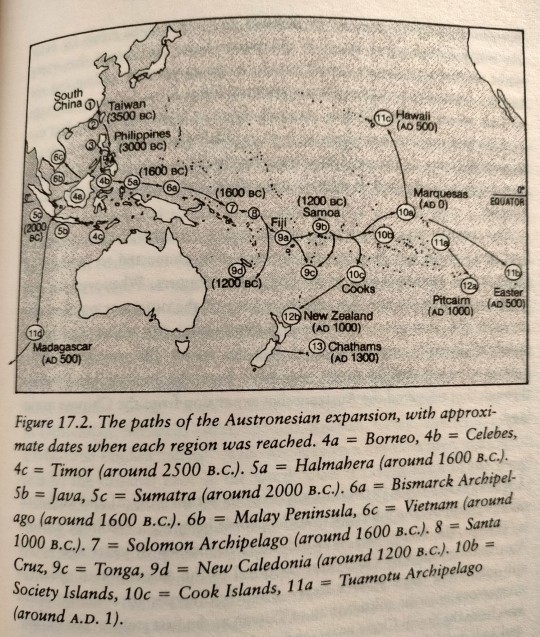
"Guns, Germs and Steel: A Short History of Everybody for the Last 13,000 Years" - Jared Diamond
#book quotes#guns germs and steel#jared diamond#nonfiction#tapenkeng#taiwan#culture#language#linguistics#austronesian
5 notes
·
View notes
